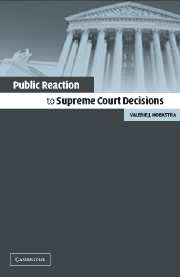Book contents
- Frontmatter
- Contents
- List of Figures
- List of Tables
- Acknowledgments
- 1 The High-Wire Act: The Supreme Court and Public Opinion
- 2 From the Marble Temple to Main Street: Placing the Cases in Political and Legal Context
- 3 Media Attention and Public Awareness
- 4 Changing Hearts and Minds? Examining the Legitimation Hypothesis
- 5 Public Support for the Supreme Court
- 6 Conclusion: Balancing Independence and Support
- Appendix A Sampling
- Appendix B Survey Instruments Included in the Analysis
- Appendix C Local and National Media Coverage of a Sample of Supreme Court Cases: 1996–97 Term
- Appendix D Statistical Issues with the Analysis of Panel Data
- References
- Index
6 - Conclusion: Balancing Independence and Support
Published online by Cambridge University Press: 02 September 2009
- Frontmatter
- Contents
- List of Figures
- List of Tables
- Acknowledgments
- 1 The High-Wire Act: The Supreme Court and Public Opinion
- 2 From the Marble Temple to Main Street: Placing the Cases in Political and Legal Context
- 3 Media Attention and Public Awareness
- 4 Changing Hearts and Minds? Examining the Legitimation Hypothesis
- 5 Public Support for the Supreme Court
- 6 Conclusion: Balancing Independence and Support
- Appendix A Sampling
- Appendix B Survey Instruments Included in the Analysis
- Appendix C Local and National Media Coverage of a Sample of Supreme Court Cases: 1996–97 Term
- Appendix D Statistical Issues with the Analysis of Panel Data
- References
- Index
Summary
LOCAL MEDIA COVERAGE
What is the nature of the relationship between the Supreme Court and public opinion? Obviously, it is a complicated one. The Supreme Court makes decisions on some of the most complex and salient issues of the day. They also resolve more routine policy questions. To some degree they are able to do so with less intense media and public scrutiny than Congress or the executive branch. But, as the results from these studies show, the institution is by no means removed from the public eye. The media, especially the local media, pay a great deal of attention to the Court – much more than previously recognized. Looking at national coverage of Court cases overlooks the simple fact that not all cases are equally newsworthy to all citizens in all media markets. If the results from this book point to anything, it is that the local media were much more likely to provide consumers with information on homegrown cases than were the national media or the media from other parts of the nation.
As detailed in Chapter 3, the local media provided both quantity and quality of coverage. Even The New York Times, this nation's paper of record, did not do a better job than the local media. The local newspapers devoted more space than did other newspapers.
- Type
- Chapter
- Information
- Public Reaction to Supreme Court Decisions , pp. 148 - 156Publisher: Cambridge University PressPrint publication year: 2003

